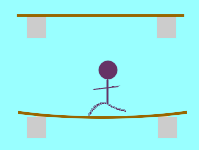Natasha Glydon
Building bridges is a common job for many architects. Aside from the geometric shapes of the bridges themselves, architects are also responsible for the engineering of safety features as well. As is the case with bridges, architects need to consider the length of the bridge, the weight it can withstand, weather conditions, etc. Different bridge structures are used for different purposes. One of the most common and mathematically interesting bridge types is the suspension bridge. Suspension bridges are useful because they can be quite long and still work effectively.
 Image reproduced with permission of Brooklyn Bridge Gallery |
In a suspension bridge, the roadway is actually hanging from large cables. The cables run over the top of two large towers (which are rooted deep into the earth) and connect to anchorages at each end of the bridge. When constructing a bridge, architects must consider the compression and tension forces that the bridge is going to have to withstand – compression and tension. Consider a long piece of wood resting on two crates. As you put weight onto the middle of the wood, the top part of the wood shortens while the underside of the piece lengthens, making the middle sag and the ends lift up. This is because compression forces are shortening the top part of the wood and tension forces are elongating the underside of the wood.

The cables and the towers of the suspension bridge are designed to deal with the weight of traffic. The towers are dug deep into the earth for stability and strength. Tension is combated by the cables, which are stretched over the towers and held by the anchorages at each end of the bridge. Wind can be detrimental to a bridge. For that reason, a deck truss is often placed under the roadway of the bridge. This provides additional stability for the bridge.
The parabolic shape of the suspension bridge is also interesting. At first glance, the curve may be described as a catenary. A catenary is a curve created by gravity, like holding the end of a skipping rope in each hand and letting it dangle. However, because the curve on a suspension bridge is not created by gravity alone (the forces of compression and tension are acting on it) it cannot be considered a catenary, but rather a parabola. The parabolic shape allows for the forces of compression to be transferred to the towers, which upholds the weight of the traffic. The parabolic shape can also be proved mathematically, using formula comparisons.
